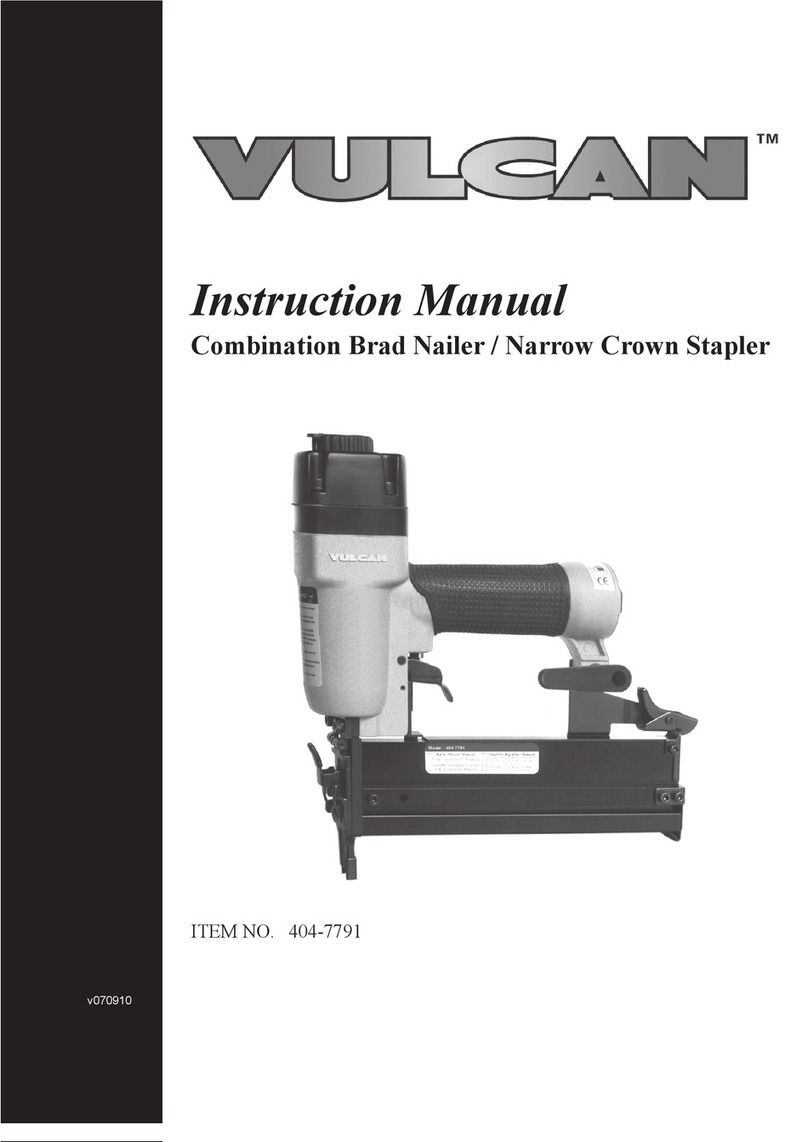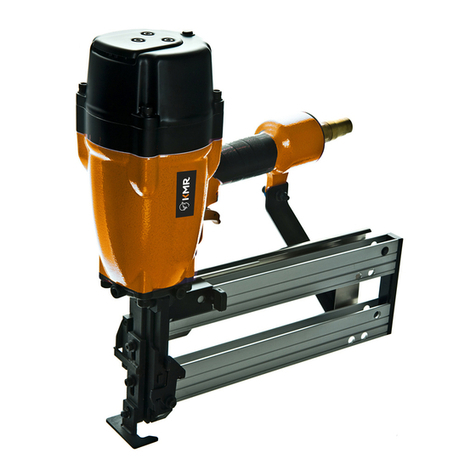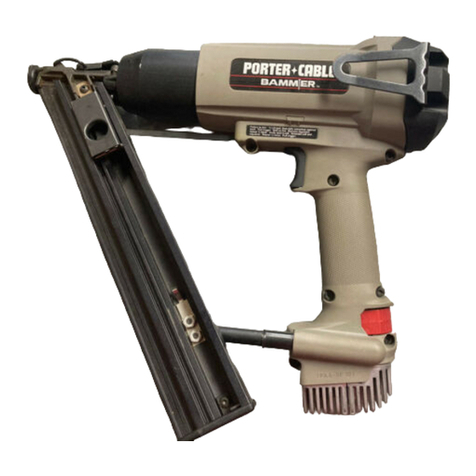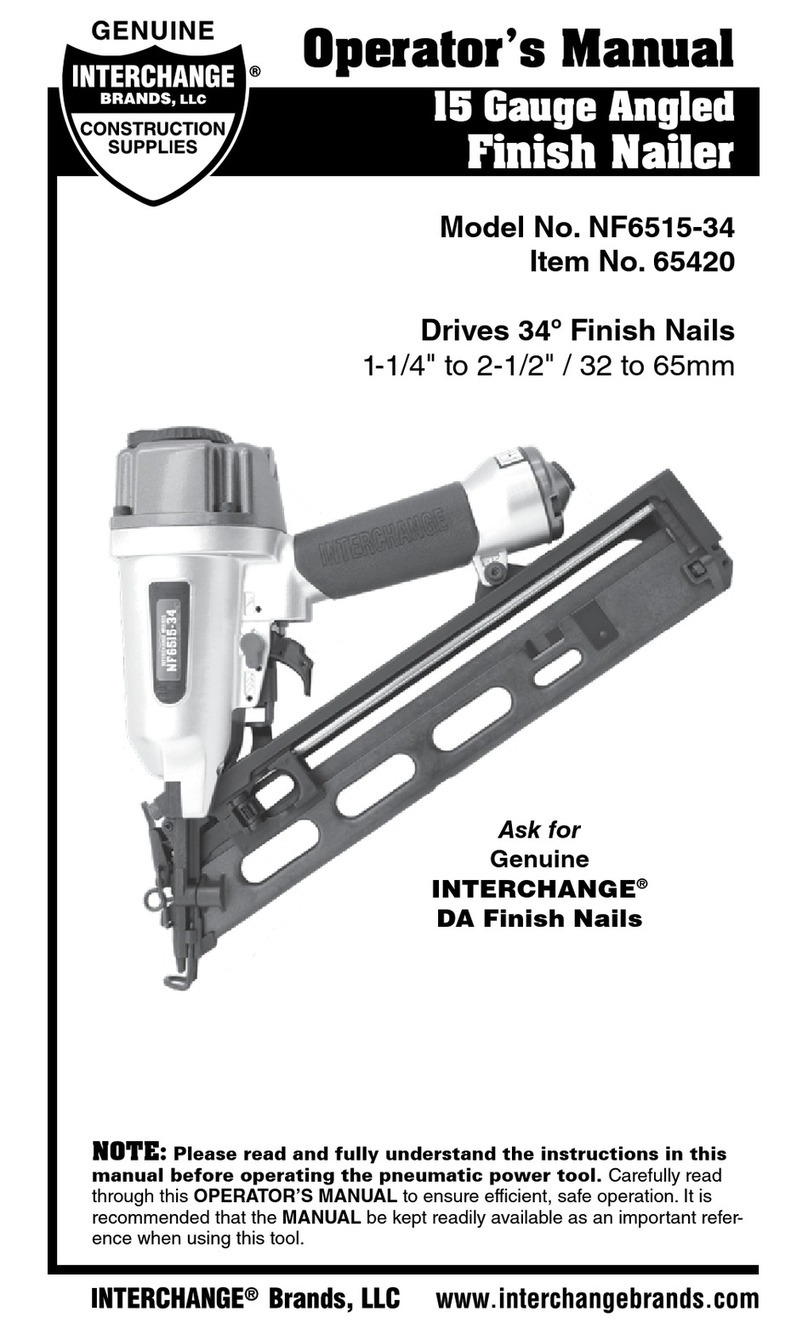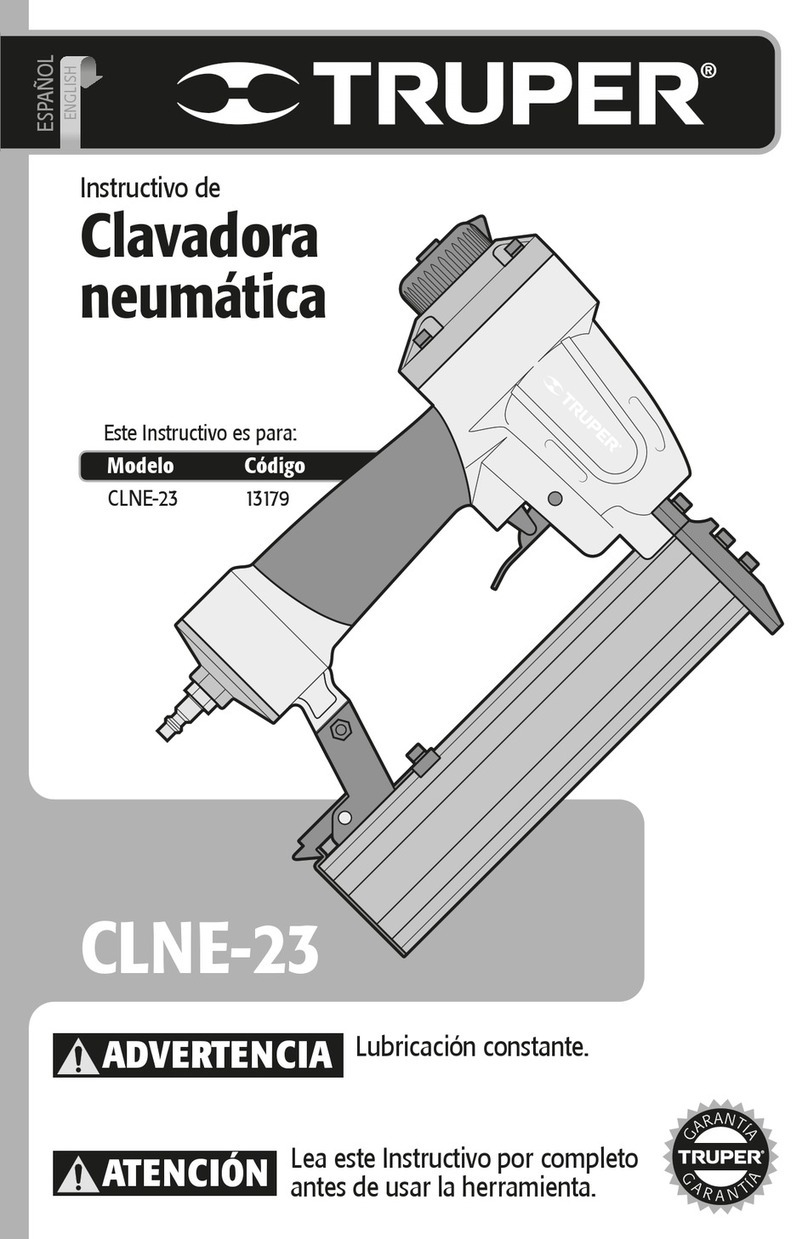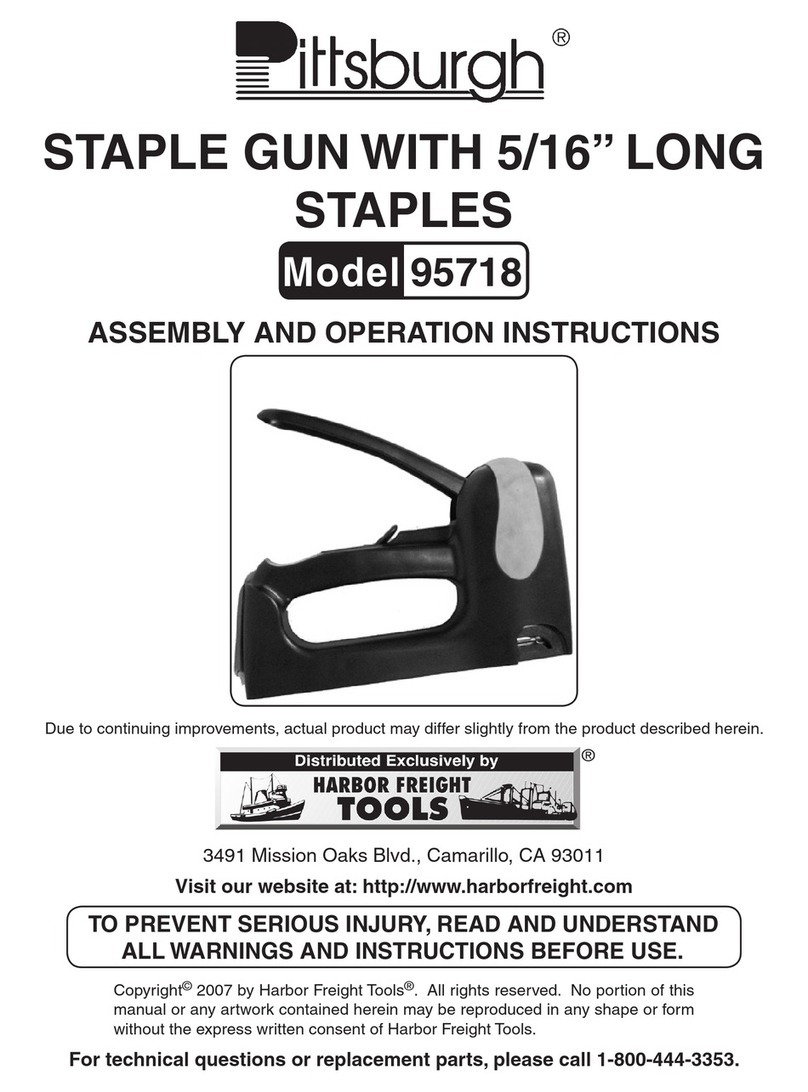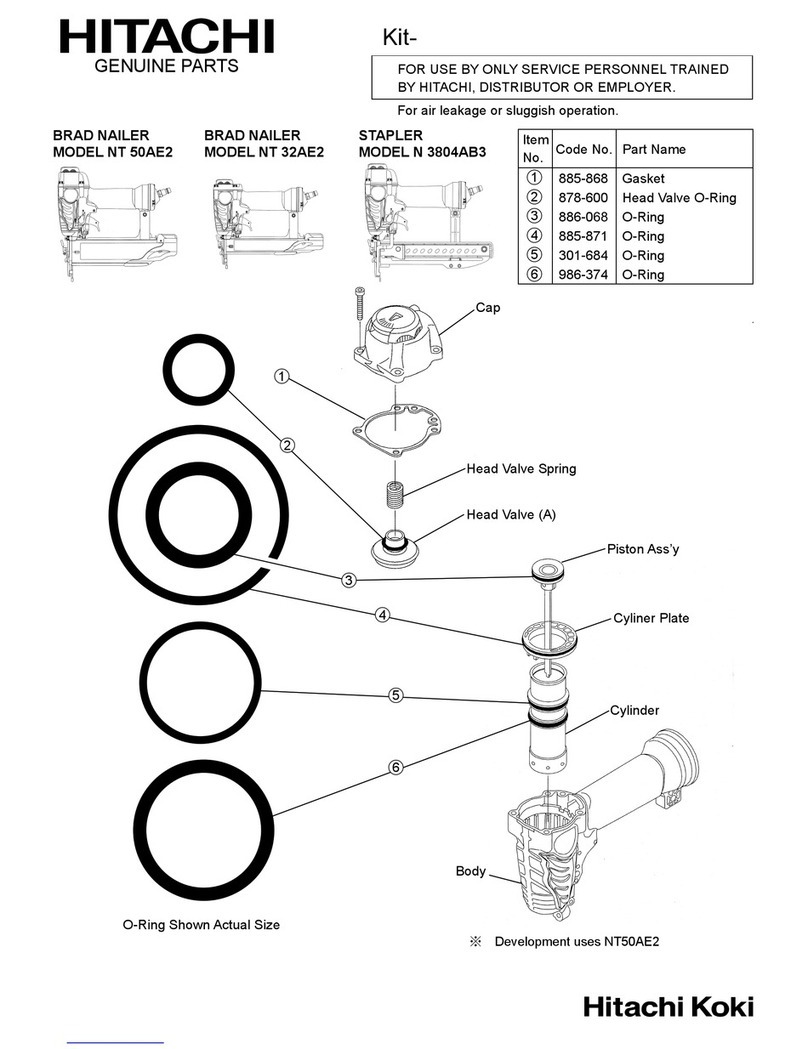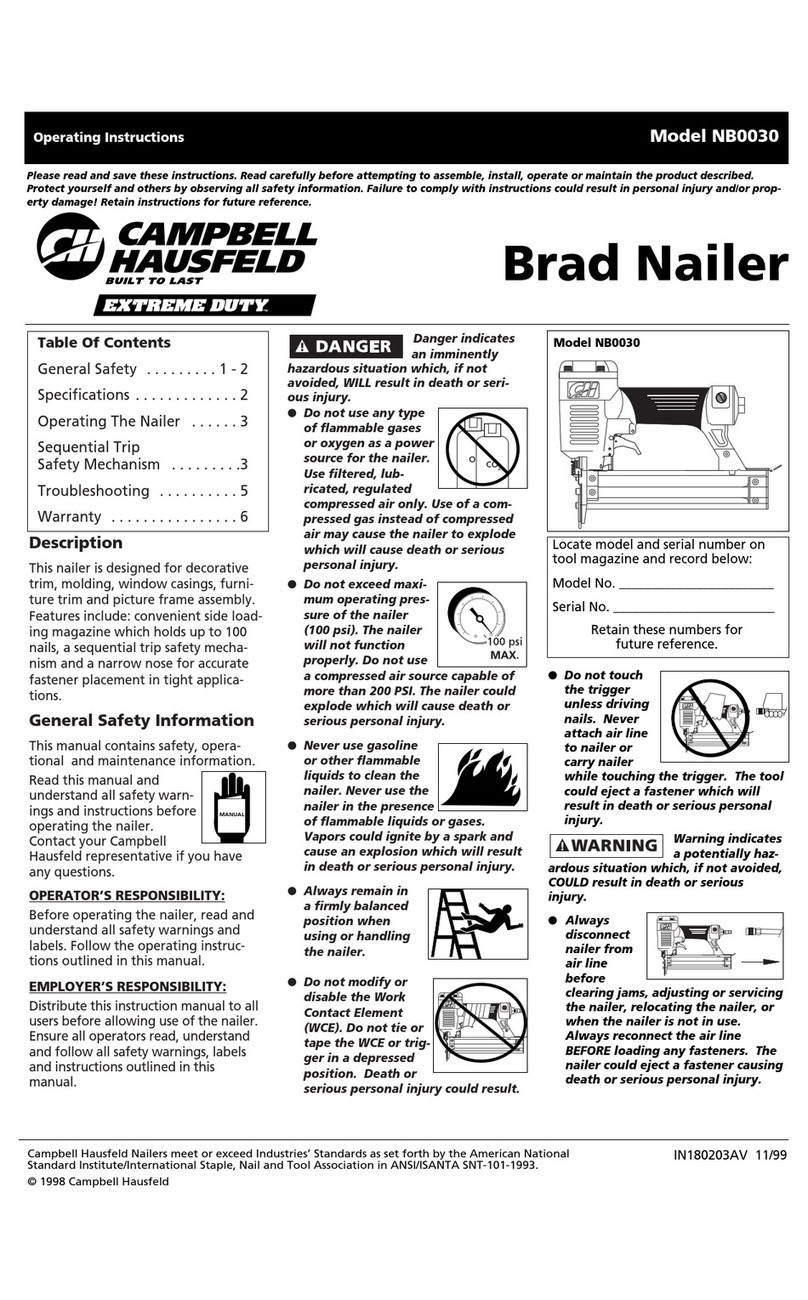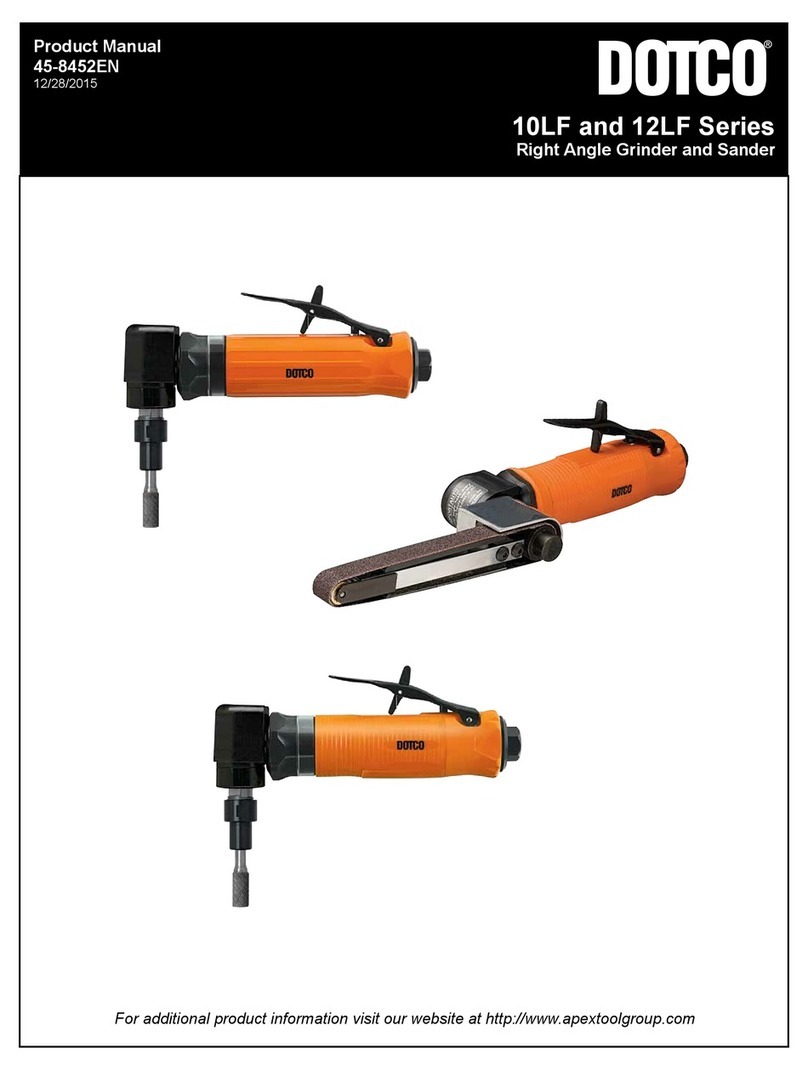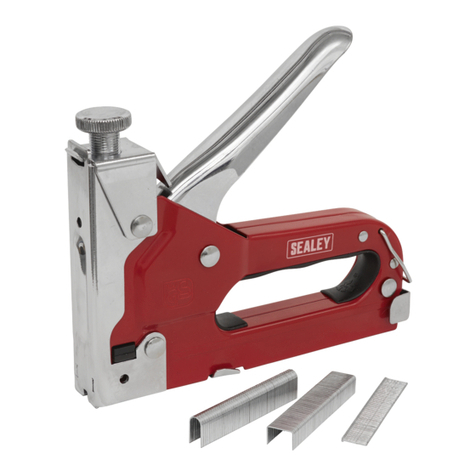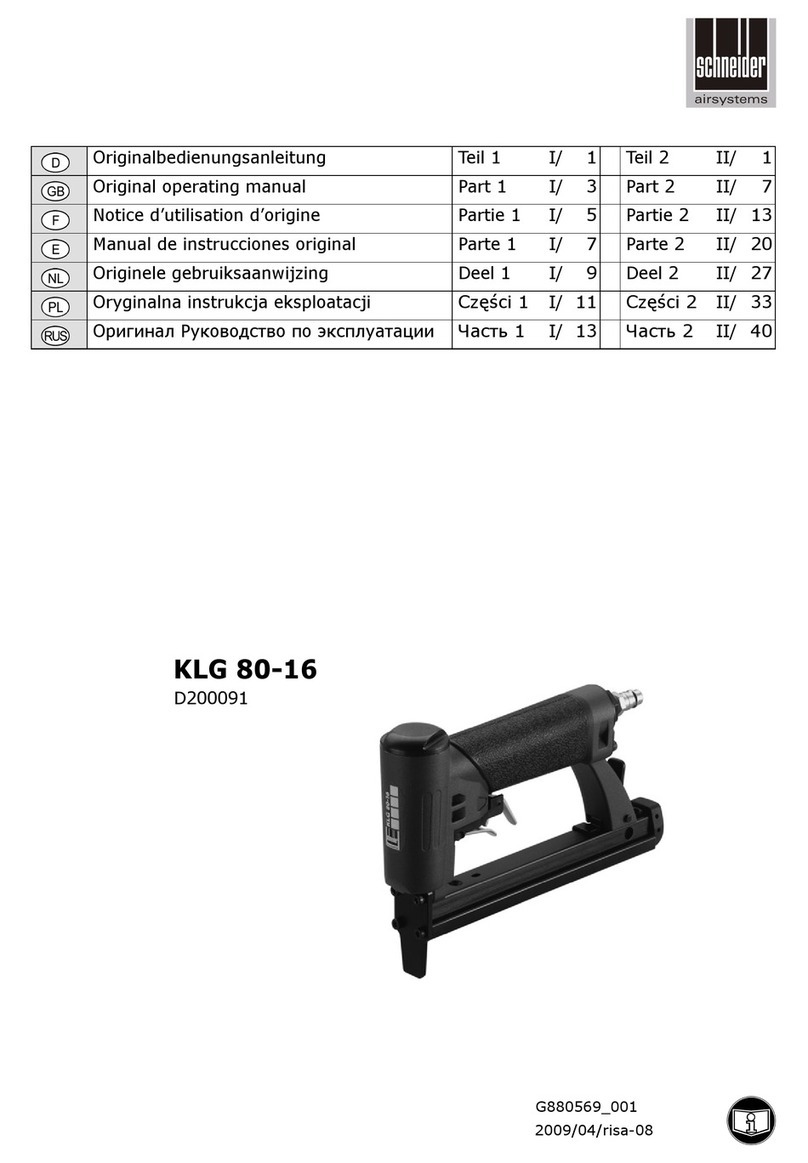Vulcan-Hart 827-1777 User manual

v070910
Instruction Manual
Manual de instrucciones
ITEM NO.
ARTÍCULO No.
2-in-1 Flooring Nailer / Stapler
827-1777

2
THANK YOU for your purchase of this Vulcan Air Tool. With proper care and
use you can expect your purchase to provide years of trouble free service!
SHOULD YOU HAVE A QUESTION OR A PROBLEM WITH YOUR
VULCAN TOOL, PLEASE CALL OUR CUSTOMER SERVICE
DEPARTMENT TOLL FREE AT:
1-800-482-0131
Please have the tool, model number and instruction manual at hand before calling.
ONE YEAR LIMITED CONSUMER WARRANTY
If you have a question or should you have a problem with any Vulcan Air Tool, call
the Vulcan Customer Service line at 1-800-482-0131.
This product is warranted to be free from defects to material and workmanship
for a period of ONE YEAR from date of purchase. If defective the product will be
repaired or replaced. Call the Vulcan Power Tool customer service line at 1-800-
482-0131 and a customer representative will attempt to help resolve any issue. If
directed by a representative, return the product along with proof of purchase to
your dealer. Normal wear, damage due to abuse or mishandling or unauthorized
repair is not covered. This warranty does not apply to accessories. This warranty
gives you specic legal rights that vary from state to state.
This tool is intended for consumer use and is not a commercial tool. In the event
the tool is used commercially, the warranty should be for a period of 30 days.
VULCAN AIR TOOLS ARE MADE EXCLUSIVELY FOR:
Memphis, TN 38101

3
SAFETY RULES FOR ALL TOOLS
Read and understand all instructions. Failure to follow all instructions listed
below may result in serious personal injury.
SAVE THESE INSTRUCTIONS
WARNING
!
Work Area
Keep work area clean and well lit. Cluttered
benches and dark areas invite accidents.
Keep by-standers, children, and visitors away
while using your tool. All children should be kept
away from the work area. Don’t let them handle
machines, tools or extension cords. Visitors can
be a distraction and are difcult to protect from
injury. Distractions can cause you to lose control.
Personal Safety
Stay alert. Watch what you are doing & use
common sense. Keep hands and body away from
the path of any potential red fastener. Do not
operate any tool when you are tired, under the
inuence of drugs, alcohol, or medication. A
moment of inattention while operating this tool
may result in serious injury.
Dress properly. Do not wear loose clothing
or jewelry; they can be caught in moving parts.
Protective, non-electrically conductive gloves
and non-skid footwear are recommended when
working. Wear protective hair covering to contain
long hair and keep it from harm. Keep hands dry,
clean and free from oil and grease.
Safety glasses To prevent eye injuries, the tool
operator and all persons in the work area must
wear ANSI Z87.1 approved safety glasses with
permanently attached, rigid side shields.
Ear protection. Wear ear protection to safeguard
against possible hearing loss.
Guard against electric shock. Prevent body
contact with grounded surfaces: pipes, radiators,
ranges, and refrigerator enclosures. Before
driving fasteners into walls, oors, or wherever
“live” electrical wires may be encountered, try to
ascertain whether there is a danger of shock.
Do not overreach. Keep proper footing and
balance at all times. Do not reach over or across
machines which are running.
Employers must enforce compliance with the
safety warnings and all other instructions
in this manual. Keep it available for use by
everyone assigned to use this tool.
Tool Use and Care
Use clamps or other practical way to secure
and support the workpiece to a stable
platform. Holding the work by hand or against
your body is unstable and may lead to loss of
control.
Store idle equipment. Store equipment in a dry
area to inhibit rust. Equipment also should be in
a high location or locked up to keep out of reach
of children.
Don’t force the tool. It will do the job better and
more safely at the rate for which it was intended.
Use the right tool. Don’t force a small tool or
attachment to do the work of a larger industrial
tool. Don’t use a tool for a purpose for which it
was not intended
Extension cords. Observe warnings that
accompany air compressors concerning the use of
correct gauge and and concerning insulation for
outdoor use.
Service
Check for damaged parts. Before using this
tool, any part that is damaged should be carefully
checked to determine that it will operate properly
and perform its intended function. Check for
alignment of moving parts, binding of moving
parts, breakage of parts, mountings, and other
conditions that may affect its operation. Inspect
screws and tighten any ones that are loose. Any
part that is damaged should be properly repaired
or replaced by an authorized service center unless
otherwise indicated elsewhere in the instruction
manual. Have defective switches replaced by an
authorized service center. Don’t use the tool if
switch does not turn it on and off properly.

4
User service. Some user-serviceable components
are described in the Troubleshooting section. We
cannot guarantee repairs made or attempted by
anyone other than authorized agencies.
Tool service must be performed only by
qualied repair personnel. Service or
maintenance performed by unqualied personnel
could result in risk of injury. For example, internal
wires may be misplaced or pinched, safety guard
return springs may be improperly mounted.
Guard against electric shock. Prevent body
contact with grounded surfaces: pipes, radiators,
ranges, and refrigerator enclosures. Before
driving fasteners into walls, oors, or wherever
“live” electrical wires may be encountered, try to
ascertain whether there is a danger of shock.
Ear protection. Wear ear protection when using
the tool for extended periods. Prolonged exposure
to high intensity noise can cause hearing loss.
Safety glasses To prevent eye injuries, the tool
operator and all persons in the work area must
wear approved safety glasses conforming to ANSI
Z87.1 specications with permanently attached,
rigid side shields.
Use clean, dry, regulated, compressed air at 60
to 100 psi.
Do not connect tool to pressure which
potentially exceeds 200 psi.
Air hose. Only use hose that is rated for a
minimum working pressure of 150 psi or 150%
of the maximum system pressure, whichever is
greater.
Never use oxygen, carbon dioxide, combustible
gases or any other bottled gas as a power
source for this tool. Explosion and serious
personal injury could result.
Couplings. Connect tool to air supply hose with a
1/4” npt coupling that removes all pressure from
the tool when the coupling is disconnnected.
Be aware of air hoses and their connections.
Don’t trip over hoses. Make sure all connections
are tight.
When servicing tool, use only identical
replacement parts. Follow instructions in
the Maintenance section of this manual. Use
of unauthorized parts or failure to follow
Maintenance instructions may create a risk of
injury. Certain cleaning agents such as gasoline,
carbon tetrachloride, ammonia, etc. may damage
plastic parts.
SAFETY RULES FOR AIR NAILERS & STAPLERS
Disconnect tool from air supply hose before
doing any disassembly, maintenance, clearing a
jammed fastener, leaving the work area, moving
the tool to another location, or handing the tool to
another person.
Never use a tool that is leaking air, has missing
or damaged parts, or requires repair. Make
sure all screws and caps are securely tightened.
Check for damaged parts. Never use a tool if
safety, trigger, or spring are inoperable, missing or
damaged. Do not alter or remove safety, trigger,
or springs. Make daily inspections for the free
movement of trigger and safety mechanism.
Replacement parts. When servicing, use
only identical replacement parts and fasteners
recommended by us.
Be sure the tool is disconnected from the air
supply before loading the fasteners. Take
care on re-connection: fasteners may be red
accidentally during connection. The fastener
driving mechanism may cycle when the tool is
connected to the air supply.
Assume the tool contains fasteners at all times.
Always keep it pointed away from yourself and
others. No horseplay. Respect the tool as having
lethal potential.
Do not load fasteners with trigger or safety
depressed. The tool may unintentionally re a
fastener.
Do not depress the trigger when not driving
fasteners. Never carry tool with nger on or
touching the trigger mechanism: tool may re an
unwanted fastener.

5
The warnings, cautions, and instructions detailed in this manual cannot cover all
possible conditions and situations that occur. It must be understood by the operator
that COMMON SENSE AND CAUTION ARE FACTORS that cannot be built into
this product, but MUST BE SUPPLIED BY THE OPERATOR.
Fire fasteners into work surface only and never
into materials too hard to penetrate
Grip tool rmly to maintain control while
allowing the tool to recoil away from the work
surface as the fastener is driven. If the safety is
allowed to recontact the work surface before the
trigger is released, an unwanted fastener will be
red.
Do not drive fasteners on top of other
fasteners, or with the tool at too steep an angle:
the fasteners can ricochet causing personal injury.
Do not drive fasteners too close to the edge
of the workpiece. The workpiece is likely to
split, allowing the fasteners to y free or ricochet
causing personal injury.
WARNING
!

6
Nomenclature for No. 827-1777
Flooring Nailer / Stapler
KEY
A Hammer Face
B Long Arm
C Air Inlet
D Magazine Lock
E Fixed Magazine
F Shoe
Characteristic Value
Minimum Operating Air Pressure 60 PSI
Maximum Operating Air Pressure 100 PSI
Nail Standard ooring
cleat nails
Nail Length 1-1/2” - 2”
Nail Capacity 100
Staples 15-1/2 ga. 1/2”
crown ooring
staples
Staple Length 3/4” - 2”
Staple Capacity 80
Air Inlet 1/4” NPT
Air Consumption 5 CFM @ 80 PSI
Tool Weight 11.5 lbs
SPECIFICATIONS

7
OPERATION & USE INSTRUCTIONS
WARNING
!
BE SURE THAT YOU READ, UNDERSTAND AND FOLLOW THE SAFETY
RULES THAT ACCOMPANY THIS MANUAL.
THIS WILL ALLOW FOR BEST USE AND MAXIMUM USER SATISFACTION.
SETUP & OPERATION
UNPACKING
Check and make sure one of each of the following are all included.
lHammer
lNailer/Stapler
lS3 Hex Key
lS4 Hex Key
lS5 Hex Key
lAir Tool Oil
lInstruction Manual
l25/32” Spacer (Installed)
l1/2” Spacer
AIR SYSTEM
lThe nailer/stapler is designed to operate on clean, dry, compressed air, regulated at
60-100 psi. The preferred system would include a lter, a pressure regulator with a
gauge, and an automatic oiler located downstream from the main air supply, as close to
the tool as possible (within 15 feet is ideal). Do not use bottled air or gases. Please see
gure below:
lAll compressed air contains moisture and other contaminants that can harm the internal
components of the tool. An air line lter will remove most of these and signicantly
prolong the life of the tool. Ensure the in-line oiler has sufcient oil. If an in-line oiler is
not available, place 2 drops of oil into the tool’s air inlet at the beginning of each workday.
More than this will be expelled from the tool’s exhaust during ring.
l Air Fitting: The nailer/stapler should be equipped with a 1/4” NPT male plug to t a ‘quick
connector’ coupling. To prevent accidental cycling even though disconnected, the tool
must always be connected to the air supply in such a way that all air pressure in it is
released when the coupling is disconnected.

8
CAUTION
!
l All air line components (including hoses, pipe, connectors, lters, & regulators, etc.) must
be rated for a minimum working pressure of 150 psi or 150% of the maximum system
pressure, whichever is greater.
lDisconnect the tool from the air supply before performing maintenance, clearing a
jammed fastener, leaving the work area, moving the tool to another location, or handing it
to another person.
LOADING THE FASTENERS
CAUTION
!
lKeep the tool pointed away from yourself and others at all times.
lDo not load fasteners with safety or trigger depressed.
lAlways wear approved safety glasses and hearing protection when preparing or operating
this tool.
lNever use a tool that leaks air or needs repair.
lBe sure the tool is disconnected from the air supply BEFORE loading fasteners
A. Loading Staples:
1. Hold the tool rmly, press the LOCK (Parts List, 46) and pull the MOVABLE
MAGAZINE (Parts List, 35).
2. Place the specied type and size of staples in the FIXED MAGAZINE (Parts List, 58)
from the topside.
3. Push and lock the movable magazine (Parts List, 35)
B. Loading “L” Cleat Nails
1. Hold the tool rmly, press the LOCK (Parts List, 46) and pull the MOVABLE
MAGAZINE (Parts List, 35).
2. Place the specied type and size of “L” cleats in the magazine from the side. The head
of the “L” cleats should be inserted into the notch on the xed magazine.
3. Push and lock the MOVABLE MAGAZINE (Parts List, 35)
CONNECTING THE TOOL
1. Turn the compressor on.
2. Set the regulator to proper pressure for the size and type of fasteners being used.
3. After reading and understanding this entire manual, connect tool to air supply.
OPERATING THE TOOL
1. The depth to which a fastener is driven is determined by the supplied air pressure.
1a. Test re a fastener into a sample of the material you will be working on and check
depth.

9
1b. Adjust the regulator to supply air at a higher pressure if increase drive depth is
desired. Decreasing supplied air pressure will result in the fastener driven depth also
being decreased.
1c. Test re another fastener and check depth again.
CAUTION
!
lKeep tool pointed in a safe direction at all times.
lNever attempt to drive fasteners into materials too hard to penetrate, at too steep an
angle, or too near the edge of the workpiece. The fastener can ricochet causing personal
injury.
lDisconnect tool from air supply before loading fasteners, doing any disassembly,
maintenance, clearing a jammmed fastener, leaving the work area, moving the tool to
another location, or handing the tool to another person.
lClean and inspect the tool daily. Carefully check for proper operation of trigger and safety
mechanism. Do not use the tool unless both the trigger and the safety mechanism are
functional, or if the tool is leaking air or needs any other repair.
2. Load the fasteners following the directions in the LOADING THE FASTENERS section.
3. Connect the tool to the air supply. Make sure the air pressure is within the minimum and
maximum operating pressures as noted in the SPECIFICATIONS section.
4. Hold the LONG ARM (Parts List, 66) and press the SHOE (Parts List, 28) against the
work surface.
5. Strike the HAMMER FACE (Parts List, 10) with the provided HAMMER (Parts List, 68)
to drive the fastener out.
6. Lift the tool off of the work surface.
7. In certain tight spaces, it may be useful to remove the handle.
8. Two spacers are provided, (Schematic, 32 & 32a). They provide a non-marring surface
on the bottom of the shoe. Choose the spacer thickness that places a fastener correctly
in the apex of the angle between the ooring tongue and its vertical edge.
CLEARING A JAMMED FASTENER
1. CAUTION
!
Disconnect the tool from the air supply.
2. Open the magazine cover. Remove any remaining fasteners from the tool.
3. Use a slender, soft steel rod to push the drive blade to its uppermost position. Remove
the jammed fastener with needle nose pliers.
4. Follow instructions in LOADING THE FASTENERS to reload fasteners.

10
TROUBLESHOOTING
STOP using the tool immediately if any of the following problems occur. Serious personal
injury could occur. Any repairs or replacements must be done by a qualied person or an
authorized service center only.
CAUTION
!
n Disconnect the tool from air supply before performing any service procedure.
n When inserting new or re-installing O-rings, make sure they are clean and lubricated with
an O-ring lubricant.
MAINTENANCE
DAILEY MAINTENANCE
CAUTION
!
lDisconnect tool from air supply before cleaning and inspection.
lCorrect all problems before putting the tool back in service.
1. Wipe tool clean and inspect for wear or damage. Use non-amable cleaning solutions to
wipe exterior of tool only if necessary. Do Not Soak tool with cleaning solutions. Such
solutions can damage internal parts.
2. Inspect trigger and safety mechanism to assure system is complete and functional: no
loose or missing parts, no binding or sticking parts.
3. Keep all screws tight. Loose screws can cause personal injury or damage the tool.
4. If the tool is used without an in-line oiler, place 2 drops of air tool oil into the
air inlet of the tool at the beginning of each workday and after about 1 hour of
continuous use. Frequent but not excessive lubrication is required for best performance.
Oil added through the airline connection will lubricate all internal parts. Use only air tool
oil. Do not use oil with detergents or other additives. These can cause damage through
accelerated wear to the seals in the tool.
5. Use a small amount of oil on all exterior moving parts and pivots.
6. Dirt and water in the air supply are major causes of pneumatic tool wear. See the section
on SETUP: AIR SYSTEM for more information.
7. Keep tools clean for better and safer performance. Use non-ammable cleaning solutions
sparingly and only if necessary. Do not soak parts in the solutions.
CAUTION
!
Such solutions may damage O-rings and other parts.
PROBLEM CAUSE SOLUTION
Air leaking in cylinder cap Loose nose screws Tighten and recheck
Gasket is cracked/worn Replace gasket

11
TROUBLESHOOTING
PROBLEM CAUSE SOLUTION
Lack of power, slow to cycle.
Poor power of shooting and
returning
Tool is too dry Place 2 drops of oil into the
air plug
Air pressure too low Check air supply equipment
Exhaust blocked Clean exhaust channel
Shooting no fastener or
intermittent feeding
Damaged pusher spring Replace spring
Wrong size of fastener Use standard fasteners
Magazine or wear plate is
dirty
Clean magazine and nose
Fastener is jammed in tool Driver channel is worn Replace wear plate
Driver is broken/worn Replace driver
Bent fasteners Use standard fasteners
PARTS LIST
Please refer to the schematic drawing on page 13
ITEM DESCRIPTION
1 Cylinder Bushing
2 Plunger
3 O-Ring 19.2 x 1.8
4 O-Ring 15.9 x 1.8
5 Poppet
6 O-Ring 42.5 x 5.4
7 O-Ring 17.5 x 2.6
8 O-Ring 57.4 x 3.5
9 Piston Assembly
10 Hammer Face
11 Screw M5 x 20
12 Cylinder Cap
13 Screw M4 x 20
ITEM DESCRIPTION
14 Spring Washer 4
15 Poppet Actuator
16 O-Ring 54.2 x 3.5
17 Seal
18 Body
19 Bumper
20 Nose
21 Screw M3 x 20
22 Spring Pin 3 x 14
23 Bafe Plate
24 Screw M5 x 14
25 Spring Washer 5
26 Blade Guide
WARNING
!
Repairs should be made by an authorized repair center.
Opening this tool could invalidate your warranty.

12
ITEM DESCRIPTION
27 Limited Nail Plate
28 Shoe
29 Joint Guider
30 Bushing
31 Screw M6 x 16
32 25/32” Spacer
32a 1/2” Spacer
33 Screw M6 x 12
34 Spring Pin 2 x 14
35 Movable Magazine
36 Spring Washer 6
37 Screw M6 x 35
38 Feeder Shoe
39 Spring
40 Bafe Lock
41 Magazine Plate
42 Screw
43 Spring
44 Screw M4 x 16
45 Limited Plate
46 Lock
47 Nut M4
ITEM DESCRIPTION
48 Spring Washer 4
49 Bushing
50 Spring Pin 3 x 12
51 Washer 4
52 Pothook
53 Screw M3 x 5
54 Spring Washer 3
55 Washer 3
56 Leaf Spring
57 Screw M3 x 8
58 Fixed Magazine
59 Spring Pin 2.5 x 10
60 Screw M3 x 6
61 Magnet
62 Rail
63 Nut M4
64 Washer
65 Clamp Screw
66 Air Plug
67 Arm
68 Hammer
PARTS LIST
Please refer to the schematic drawing on page 13

13
SCHEMATIC DRAWING
Table of contents
Other Vulcan-Hart Nail Gun manuals

